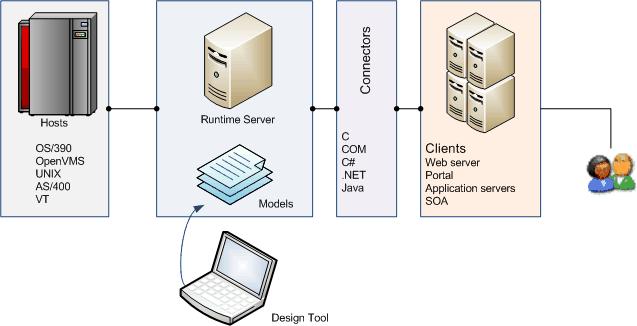Development Process
To build a Host Integrator application, follow these steps:
-
Plan your integration project
To create a good model of a host application you must have a basic understanding of the business problem that you want the model to solve. There are guidelines available to help you plan your project in Planning the Project.

-
Create and deploy the host application model
There are a few steps you must follow to create and deploy a model.
- Navigate through the host application, identifying the screens and fields that lead to the data that you want to integrate into the new Web or client/server application.
- Expose the resulting components as database tables and procedures. A table is a database abstraction with attributes or recordset fields structured in table columns. You can create a procedure that defines how Host Integrator locates, retrieves, updates, inserts, or deletes the data when it fulfills a request through SQL or through another API. If you want to add functionality beyond what is provided in the Design Tool, you can add event handlers that extend or override default model behavior.
- Test your model to confirm that it operates as you expect.
- Deploy the model to a folder containing the model file and any supporting files on the Host Integrator server. Web services are automatically provided by the session server as an embedded SOAP stack or as a REST service after a model package is deployed using the Design Tool. The embedded Web service supports all model procedures and features, including executeSQLStatement and ProcessString event handlers. See About Verastream Web Services for detailed information on Host Integrator Web services.
-
Build a new Web or client/server application
You can build a new application using these options:
- Use Web Builder to quickly build and deploy a Web application. You can build a Web application for a Java, .NET, or ASP interface, and then launch a standard editor for any of these interfaces to extend or modify the Web application.
- Use Web Builder to generate a component interface that provides access to the procedures and screens in a host model. Component interfaces are available using Java Beans or .NET 2.0 class libraries.
- Use the IDE of your choice to consume Verastream-generated components. Mix and match components or services to create composite applications. You can use the Host Integrator connectors to develop a new client/server or Web application. Using these APIs, a developer can write a client/server or Web application without extensive knowledge of how the host application works.
-
Deploy the application to the enterprise
In a production environment, the deployed Host Integrator servers provide dynamic load balancing and failover in transaction-intensive environments. Host Integrator supports all mainframe-based security packages and also has its own multi-level security, which can be tied to the security schema of the selected deployment platform (Windows or Linux).
-
Using the Administrative Console
The rich Administrative Console user interface keeps mass management in mind and provides central administration of the management server and Host Integrator servers. It is here you will be able to:
- Maintain control over sessions and pools
- Monitor logging of session information, activity, use and status
- Configure external reporting
- Configure SNMP and JMX support for third party consoles
- Manage models and edit model properties